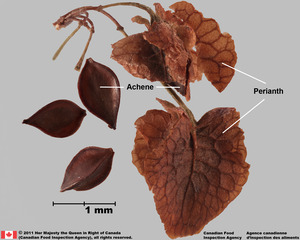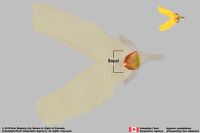Content is from Kirkbride et al. 2006Kirkbride et al. 2006:
Kirkbride JH, Jr, Gunn CR, and Dallwitz MJ. 2006. Family guide for fruits and seeds, vers. 1.0. Accessed September 2020-January 2022. URL: https://nt.ars-grin.gov/seedsfruits/keys/frsdfam/index.cfm ., without modification.
Updates are forthcoming.
Fruits: Pistil(s) simple; 1; 1-pistillate; with (1-)2–18, usually 3 for Cabomba & 12–18 for Brasenia. Fruit anthocarpanthocarp:
simple or compound and including some tissue of non-ovarian origin (accessory tissue) , or pericarpium; multiplemultiple:
, or pericarpium; multiplemultiple:
fruit formed from several flowers clustered in one mass
; achenetum (Brasenia Spjut Fig. 4A-B); multiplemultiple:
fruit formed from several flowers clustered in one mass
; diclesetum (Cabomba & 2 families Cabombaceae & Coriariaceae); without persistent central column; within accessory organ(s); within perianthperianth:
collective term for calyx and corolla of a flower
 , or sepalssepal:
, or sepalssepal:
a member of the outer envelope of a flower (calyx) (at least Brasenia); with (1–)2–18-carpellate (commonly 3 for Cabomba & 12–18 for Brasenia); with carpels separate; with carpels separating at stylestyle:
(at least Brasenia); with (1–)2–18-carpellate (commonly 3 for Cabomba & 12–18 for Brasenia); with carpels separate; with carpels separating at stylestyle:
in a flower, the narrow and elongated part of the pistil between the stigma and the ovary; sometimes persisting in fruit ; without sterilesterile:
; without sterilesterile:
lacking male and/or female reproductive parts; also, not producing fruit or seed
 carpels; apexapex:
carpels; apexapex:
the point farthest from the point of attachment, or the "tip" of an organ not beaked; wall leatheryleathery:
not beaked; wall leatheryleathery:
texture—moderately thick, tough, and very pliable
; indehiscentindehiscent:
not opening on its own, as in a fruit
 . Epicarpepicarp:
. Epicarpepicarp:
outer layer of fruit wall or pericarp, if divided into layers; note here used synonymously with exocarp durable; glabrousglabrous:
durable; glabrousglabrous:
without hairs
; with armature, or without armature; with spines; without armature glochidiate; smooth, or not smooth; without wing(s); without apicalapical:
at or pertaining to the end of the seed or fruit distal from its point of attachment (i.e., base)
respiratory hole. Endocarpendocarp:
the inner layer of the pericarp, if divided into layers present; not separating from exocarpexocarp:
present; not separating from exocarpexocarp:
outer layer of fruit wall or pericarp, if divided into layers; note here used synonymously with epicarp ; thin; not splitting into 1-seeded pyrenes; smooth; without wing; without operculumoperculum:
; thin; not splitting into 1-seeded pyrenes; smooth; without wing; without operculumoperculum:
a dehiscent cap (or lid) of a seed or fruit that opens during germination or dehiscence ; without secretory cavities; with mechanism for seedling escape; without longitudinallongitudinal:
; without secretory cavities; with mechanism for seedling escape; without longitudinallongitudinal:
of or relating to length or the lengthwise dimension
ridges. Funiculusfuniculus:
(alt. funicle) stalk connecting the ovule (later seed) to the ovary (later fruit) placenta short; short without seed bearing hookswith hooks:
short; short without seed bearing hookswith hooks:
bristles or spines with curved or backwards pointing tips, or with secondary bristles along their length (retinacula); not persisting in fruit after seed shed.
(retinacula); not persisting in fruit after seed shed.
Seeds: Arilaril:
(broad sense) appendicular structure that wholly or partly envelops a seed and is produced from or a modification of the funicle, raphe, or outer integument; usually fleshy or pulpy, sometimes spongy or tufted-capillate, often brightly colored absent. Seed larger than minute; not bowl shaped; not nutlike; without winglike beakbeak:
absent. Seed larger than minute; not bowl shaped; not nutlike; without winglike beakbeak:
a usually firm, terminal appendage, sometimes tapered ; without caudatecaudate:
; without caudatecaudate:
tapering to a long, tail-like appendage appendage(s); at maturity with food reserves; with endosperm, or perispermperisperm:
appendage(s); at maturity with food reserves; with endosperm, or perispermperisperm:
seed nutritive tissue comparable to the endosperm, but derived from the nucellus (maternal tissue)
; without canavanine. Sarcotestasarcotesta:
pulpy or fleshy outer layer of the seed coat, simulates aril absent. Testatesta:
absent. Testatesta:
seed coat
 present; without fleshy or leatheryleathery:
present; without fleshy or leatheryleathery:
texture—moderately thick, tough, and very pliable
layer over hard layer; dulldull:
reflecting only a low proportion of incident light, with no apparent sheen ; surface smooth, or unsmooth; surface with merged raised features; surface reticulatereticulate:
; surface smooth, or unsmooth; surface with merged raised features; surface reticulatereticulate:
surface relief—netted, raised walls or concave grooves forming a net-like surface pattern with flat, concave, or convex interspaces ; without crease or line separating cotyledons from hypocotyl-radicle; without notch along margin where cotyledons from hypocotyl-radicle tip approach each other; without glands; without bristles; without wings; without collar; with operculumoperculum:
; without crease or line separating cotyledons from hypocotyl-radicle; without notch along margin where cotyledons from hypocotyl-radicle tip approach each other; without glands; without bristles; without wings; without collar; with operculumoperculum:
a dehiscent cap (or lid) of a seed or fruit that opens during germination or dehiscence ; colored; monochrome; not becoming mucilaginousmucilaginous:
; colored; monochrome; not becoming mucilaginousmucilaginous:
resembling mucilage; moist and sticky
when wetted; surrounding food reserve. Endosperm development helobial, or cellular; scant. Perispermperisperm:
seed nutritive tissue comparable to the endosperm, but derived from the nucellus (maternal tissue)
copious; with starch; opaqueopaque:
not transmitting light
. Embryo differentiated from food reserve; well developed; 1 per seed; partially filling testatesta:
seed coat
 (with food reserve); 0.07 times the length of food reserve; at one end of seed not extending into a depression or cup; basalbasal:
(with food reserve); 0.07 times the length of food reserve; at one end of seed not extending into a depression or cup; basalbasal:
at or pertaining to the point of attachment; (of embryo) embryo occupies one end of the seed
; lenticularlenticular:
3D shape—lens-shaped; biconvex ; lenticularlenticular:
; lenticularlenticular:
3D shape—lens-shaped; biconvex , or shield shaped; transversetransverse:
, or shield shaped; transversetransverse:
lying, situated, or placed across
to seed length; capping one end of perispermperisperm:
seed nutritive tissue comparable to the endosperm, but derived from the nucellus (maternal tissue)
; with cotyledons gradually connected to hypocotyl-radicle; without coleorhiza; without simmondsin; without stomata; not green; with 2 or more cotyledons. Cotyledons 2; tiny; not concealing hypocotyl-radicle; smooth; with apicesapex:
the point farthest from the point of attachment, or the "tip" of an organ entire; with margins separate; basally entire; unequal in size; not punctatepunctate:
entire; with margins separate; basally entire; unequal in size; not punctatepunctate:
surface relief—dotted with pits or with translucent, sunken glands or with colored dots, similar to pitted dotted. Hypocotyl-radicle vestigial; straight; much thickened.
dotted. Hypocotyl-radicle vestigial; straight; much thickened.
Noxious weeds: 1 or more USA state noxious weeds in this family.
USA states and territories with listed noxious weeds: California (CA), Maine (ME), New Hampshire (NH), Puerto Rico (PR), Vermont (VT), and Washington (WA).
USA state and territory noxious weeds:
Brasenia schreberi J. F. Gmel.: USA state noxious weed: PRª.
Cabomba caroliniana A. Gray: USA state noxious weed: CAª, MEª, NHª, PRª, VTª, WAª.
Symbols: ªaquatic weed; ●terrestrial weed; °weed in seed.
Last updated February 2006.
General references: Baillon, H.E. 1866–95. Histoire des plantes, 13 vols. Hachette & Co., Paris, Cronquist, A. 1981. An integrated system of classification of flowering plants, 1,262 p. Columbia University Press, New York, Goldberg, A. 1986 (dicots) & 1989 (monocots). Classification, evolution, and phylogeny of the familes of Dicotyledons. Smithsonian Contr. Bot. 58 for dicots (314 pp.) & 71 for monocots (74 pp.). [Goldberg's illustrations are reproduced from older publications and these should be consulted], Gunn, C.R., J.H. Wiersema, C.A. Ritchie, & J.H. Kirkbride, Jr. 1992 & amendments. Families and genera of Spermatophytes recognized by the Agricultural Research Service. Techn. Bull. U.S.D.A. 1796:1–500, LeMaout, E. & J. Decaisne. 1876. A general system of botany, 1,065 p. Longmans, Green, & Co., London, Mabberley, D.J. 1987. The plant-book, 706 p. Cambridge University Press, Cambridge, Martin, A.C. 1946. The comparative internal morphology of seeds. Amer. Midl. Naturalist 36:513–660, and Spjut, R.W. 1994. A systematic treatment of fruit types. Mem. New York Bot. Gard. 70:1–182..